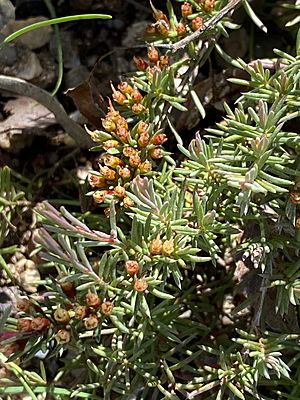Homoranthus vagans facts for kids
Quick facts for kids Homoranthus vagans |
|
|---|---|
 |
|
| Scientific classification | |
| Genus: |
Homoranthus
|
| Species: |
vagans
|
Homoranthus vagans is a special plant that belongs to the myrtle family. It's found only in a small part of southern Queensland, Australia. This means it's an endemic species, which is like saying it's a local celebrity plant!
This plant is a shrub with unique, pointed leaves and pretty yellow flowers. These flowers grow in groups of up to ten, tucked into the leaf axils (the spot where a leaf meets the stem). So far, we know of only two small groups of these plants growing in the wild.
Contents
What Does Homoranthus vagans Look Like?
Homoranthus vagans is a small shrub. It usually grows to be about 5 to 20 centimeters (2 to 8 inches) tall. It can spread out quite a bit, from 0.5 to 2 meters (1.5 to 6.5 feet) wide.
Its leaves are a dull grey-green color and have a nice smell. They are shaped like blades and grow in pairs opposite each other along the stem. The flowers are yellow and stand upright. You can usually see them blooming between August and October.
How Did It Get Its Name?
Scientists officially described Homoranthus vagans for the first time in 2011. The botanists who named it were Lachlan Copeland, Lyndley Craven, and Jeremy Bruhl. Lachlan Copeland collected the first sample of the plant in 2001.
The plant's specific name, vagans, comes from the Latin word vagus. This word means "wandering" or "unsettled." It was chosen because the young branches of this plant tend to "wander" or spread along the ground. Sometimes, these wandering branches even grow new roots into the soil!
Where Does Homoranthus vagans Live?
This unique plant is found in just two small areas. Both locations are north west of Inglewood in Queensland.
Homoranthus vagans likes to grow in sandy soil. This soil comes from sandstone rocks, which means it's often deep and well-drained.
Why Is Homoranthus vagans Important?
Scientists are keeping a close eye on Homoranthus vagans. It's currently known from only two small groups of plants. These plants grow on land that is leased, which means it's not fully protected.
Because there are so few of them, this plant is considered vulnerable. This means it could be at risk of disappearing if we don't protect its habitat. Protecting special plants like Homoranthus vagans helps keep our planet's amazing variety of life safe for the future.

